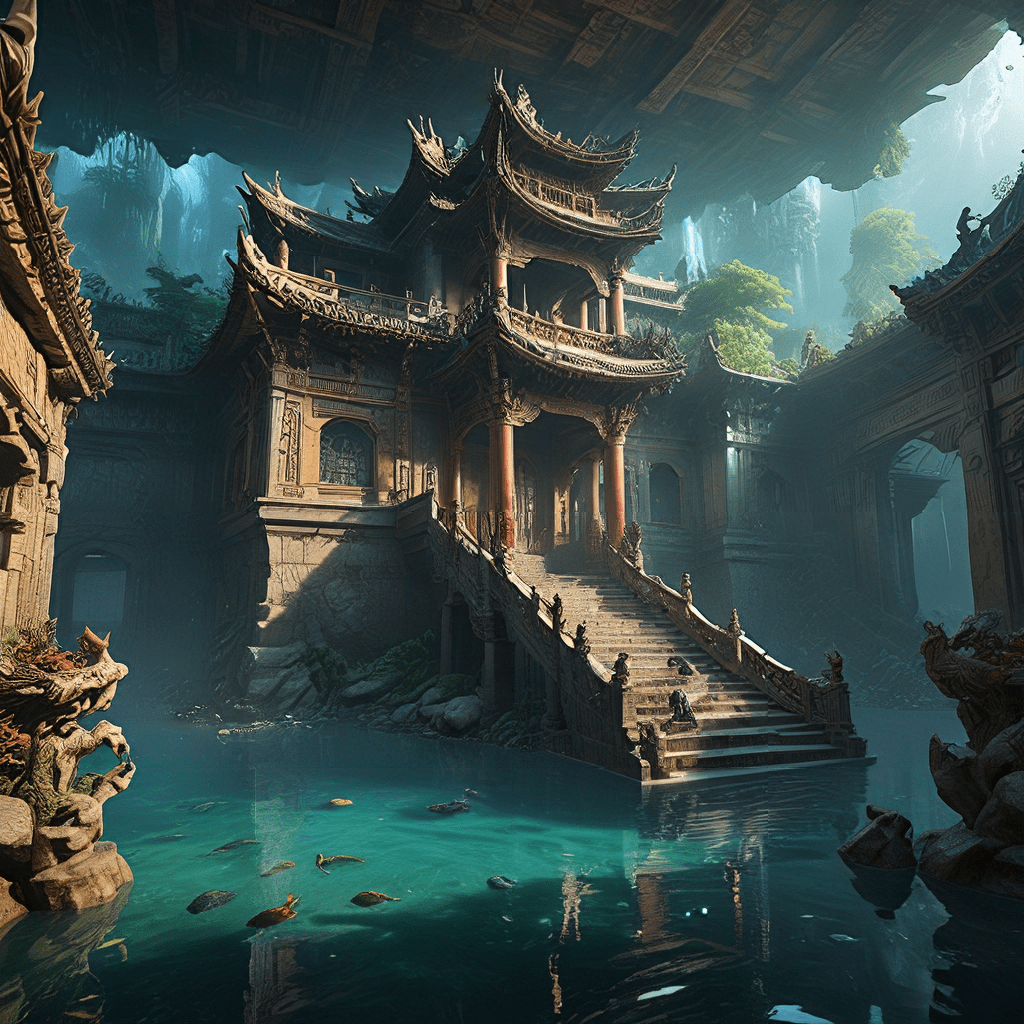The Dragon King’s Palace: A Realm of Myth and Legend
In the rich tapestry of Korean folklore, the Dragon King, or Yongwang, reigns supreme over the watery depths, a powerful and enigmatic figure who embodies the mystical and magical forces of the ocean. His underwater palace, a magnificent structure teeming with mythical creatures and treasures, is a place of wonder and awe, a realm that has captivated the imaginations of Koreans for centuries. The legend of the Dragon King and his palace is deeply intertwined with Korean culture, religion, and art, offering a glimpse into the beliefs and values that shaped Korean society.
The Dragon King: Guardian of the Seas
The Dragon King, a being of immense power and wisdom, is the guardian of the sea, presiding over all forms of aquatic life. He is typically depicted as a serpentine dragon, often with four legs and a powerful mane, embodying the strength and grace of the ocean. He is believed to control the tides, storms, and the flow of water, wielding the power to bring both blessings and curses upon humankind. In Korean mythology, the Dragon King is often associated with rain, seen as a bringer of life-giving water and bountiful harvests. He is also considered a protector of fishermen and sailors, guiding their journeys and ensuring their safety on the vast and treacherous seas.
The Palace: A Marvel of Architectural Spectacle
The Dragon King's palace, a glittering underwater realm, is said to be a breathtaking spectacle of architectural grandeur. Constructed from coral, jade, and precious gemstones, the palace shimmers with iridescent hues, reflecting the vibrant colors of the ocean. Its walls are adorned with intricately carved dragons and other mythical creatures, while its ceilings are adorned with shimmering pearls and precious jewels. The palace is said to be filled with magnificent gardens, flowing waterfalls, and crystal-clear pools teeming with exotic fish and marine life. The palace is a testament to the Dragon King's wealth and power, a symbol of his dominion over the underwater world.
The Realm of the Dragon King: Jewels, Treasures, and Magic
Within the Dragon King's palace, untold treasures and magical objects are said to be kept, guarded by mystical creatures and ancient spirits. The palace houses a vast collection of pearls, jade, and other precious stones, each possessing unique magical properties. The Dragon King's scepter, a powerful artifact that can control the tides and storms, is said to be kept in the palace's most sacred chamber. The Dragon King's palace is a place where wishes are granted, where magic flows freely, and where the boundaries between the human and spirit worlds blur.
The Dragon King’s Influence on Korean Culture and Religion
The Dragon King's palace has profound influence on Korean culture, religion, and folklore. The Dragon King is often featured in traditional rituals, particularly those related to rainmaking and fishing. Many temples and shrines are dedicated to the Dragon King, where people offer prayers and sacrifices in hopes of receiving his blessings. The legend of the Dragon King appears in countless Korean folktales and literary works, reflecting the enduring fascination with the ocean and its mythical denizens.
The Dragon King in Korean Literature and Art
The Dragon King's palace and its enigmatic ruler have captivated the imaginations of Korean artists and writers for centuries. The Dragon King appears frequently in Korean literature, often as a powerful and benevolent figure, granting wishes and protecting those who respect him. The tale of "The Fisherman and the Dragon King's Daughter," a classic Korean folktale, is a popular example of this theme. In this story, a fisherman helps a young dragon princess escape her father's palace, ultimately earning her love and a reward from the Dragon King.
The Dragon King is also a popular subject in Korean art, represented in paintings, sculptures, and other traditional forms. These depictions range from majestic and awe-inspiring representations of the Dragon King himself to scenes from his underwater palace. The palace is often portrayed as a breathtakingly beautiful and intricate realm, filled with vibrant colors, sparkling jewels, and mythical creatures. These artistic works offer a glimpse into the enduring cultural significance of the Dragon King and his underwater palace in Korean society.
The Dragon King’s Palace: A Symbol of Power and Authority
The Dragon King's palace, with its opulent architecture, vast treasures, and mystical aura, serves as a potent symbol of power and authority. It represents the Dragon King’s dominion over the ocean, his ability to control the natural forces of the sea, and his mastery over the spirit world. The palace also embodies the Dragon King’s justice and wisdom, his role as a protector of the seas and a dispenser of blessings.
For centuries, this symbol of power has resonated deeply with the Korean people, representing the aspirations for strength, prosperity, and harmony with nature. Even today, the Dragon King and his palace remain powerful symbols of Korean history, culture, and belief.
Theories on the Origin of the Dragon King Myth
The origins of the Dragon King myth are deeply intertwined with Korean history and the region’s geographical landscape. The Korean peninsula is surrounded by the sea, which has played a significant role in shaping Korean culture and economy. The sea provided a vital source of food and transportation, but also presented dangers and challenges. These realities likely contributed to the development of the Dragon King myth, a story that reflected the reverence for the ocean and its powerful forces.
Some scholars believe the Dragon King myth originated from ancient animistic beliefs, where nature was believed to be inhabited by spirits and deities. Others suggest that the myth was influenced by Buddhist beliefs, which introduced the concept of powerful beings who ruled over various realms. Regardless of its precise origins, the Dragon King myth has been a significant part of Korean culture for centuries, reflecting the enduring fascination with the ocean and its mysteries.
The Dragon King’s Palace: A Reflection of Korean Society and Ideals
The Dragon King's Palace, as a mythical realm of beauty, wealth, and power, also reflects certain aspects of Korean society and ideals. The palace’s grandeur, its intricate architecture, and its abundant treasures represent a yearning for prosperity and success. The Dragon King’s role as a protector and benevolent ruler symbolizes the importance of harmony and order within Korean society. The palace’s location beneath the sea, where it is hidden from human eyes, might also reflect a desire for peace and tranquility.
This mythical palace and its ruler represent the Korean people’s deep connection to their natural environment, their reverence for nature’s power, and their appreciation for the beauty and mystery of the world around them.
The Dragon King’s Palace: A Source of Inspiration and Wonder
The Dragon King's Palace, with its captivating blend of mythology, art, and culture, has inspired generations of Koreans to dream of wondrous and impossible realms. It serves as a powerful reminder to be respectful of the natural world and its hidden forces, while also symbolizing the human desire for beauty, mystery, and adventure.
This ancient tale continues to fascinate and inspire, reminding us that even in the modern world, there is still magic and wonder to be found in the stories and legends that have shaped our history and culture.
FAQ
**Q: What is the Dragon King’s Palace?**
A: The Dragon King's Palace is a mythical underwater realm, the home of the Dragon King, a powerful being who rules over the sea in Korean folklore.
Q: What is the Dragon King like?
A: The Dragon King is typically depicted as a serpentine dragon with four legs and a powerful mane. He is a wise and powerful being, controlling the tides, storms, and aquatic life.
Q: What is the Dragon King's Palace like?
A: It is a magnificent palace, built from coral, jade, and precious gemstones. It is filled with treasures, magical objects, and mythical creatures.
Q: How does the Dragon King's Palace influence Korean culture?
A: The palace features prominently in Korean folklore, art, and literature, representing themes of power, authority, and harmony with nature.
Q: What is the significance of the Dragon King's Palace?
A: The Dragon King's Palace symbolizes the Korean people's reverence for the ocean, their desire for prosperity and peace, and their endless fascination with the world's mysteries.


